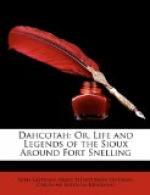The scenery about Fort Snelling is rich in beauty. The falls of St. Anthony are familiar to travellers, and to readers of Indian sketches. Between the fort and these falls are the “Little Falls,” forty feet in height, on a stream that empties into the Mississippi. The Indians call them Mine-hah-hah, or “laughing waters.” In sight of Fort Snelling is a beautiful hill called Morgan’s Bluff; the Indians call it “God’s House.” They have a tradition that it is the residence of their god of the waters, whom they call Unk-ta-he. Nothing can be more lovely than the situation and appearance of this hill; it commands on every side a magnificent view, and during the summer it is carpeted with long grass and prairie flowers. But, to those who have lived the last few years at Fort Snelling, this hill presents another source of interest. On its top are buried three young children, who were models of health and beauty until the scarlet fever found its way into regions hitherto shielded from its approach. They lived but long enough on earth to secure them an entrance into heaven. Life, which ought to be a blessing to all, was to them one of untold value; for it was a short journey to a better land—a translation from the yet unfelt cares of earth to the bright and endless joys of heaven.
Opposite the Fort is Pilot Knob, a high peak, used as a burial-place by the Indians; just below it is the village of Mendota, or the “Meeting of the Waters.”
But to me, the greatest objects of interest and curiosity were the original owners of the country, whose teepees could be seen in every direction. One could soon know all that was to be known about Pilot Knob or St. Anthony’s falls; but one is puzzled completely to comprehend the character of an Indian man, woman, or child. At one moment, you see an Indian chief raise himself to his full height, and say that the ground on which he stands is his own; at the next, beg bread and pork from an enemy. An Indian woman will scornfully refuse to wash an article that might be needed by a white family—and the next moment, declare that she had not washed her face in fifteen years! An Indian child of three years old, will cling to its mother under the walls of the Fort, and then plunge into the Mississippi, and swim half way across, in hopes of finding an apple that has been thrown in. We may well feel much curiosity to look into the habits, manners, and motives of a race exhibiting such contradictions.
There is a great deal said of Indian warriors—and justly too of the Sioux. They are, as a race, tall fine-looking men; and many of those who have not been degraded by association with the frontier class of white people, nor had their intellects destroyed by the white man’s fire-water, have minds of high order, and reason with a correctness that would put to the blush the powers of many an educated logician. Yet are these men called savages, and morally associated with the tomahawk and scalping knife. Few regard them as reasonable creatures, or as beings endowed by their creator with souls, that are here to be fitted for the responsibilities of the Indians hereafter.




